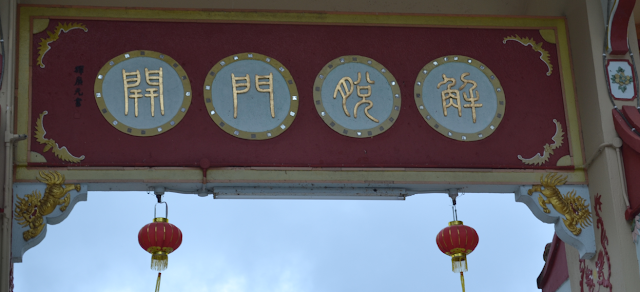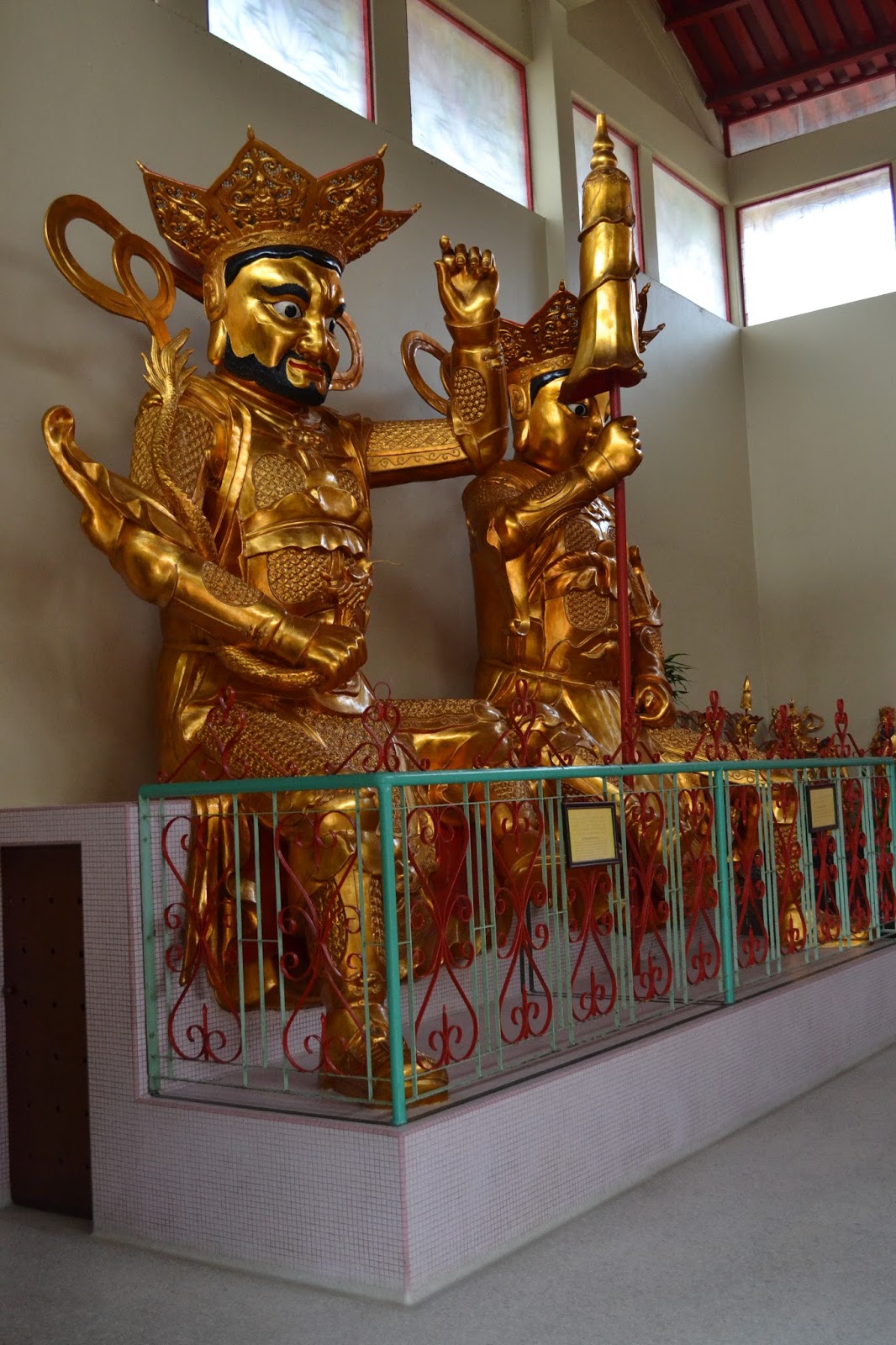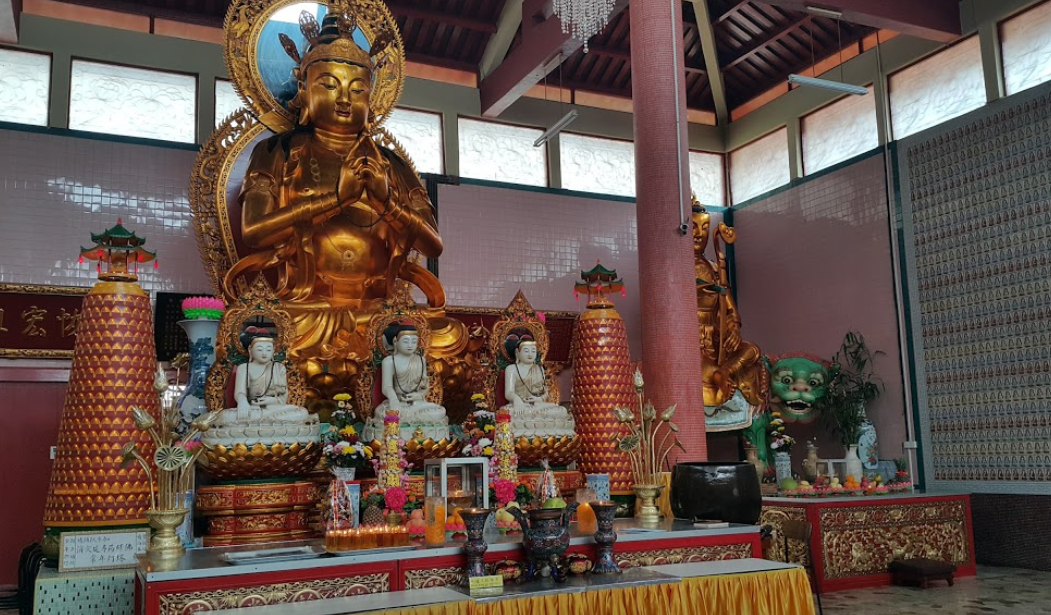 |
Perched on a hill, Sam Poh Wan Futt Chi is not exactly easy to access. The temple is surprisingly large for a small town and has a commendable facade and interior.
The Sam Poh Wan Futt Chi ( 三宝万佛寺) or Triple Gem Ten Thousand Buddhas Monastery is a Mahayana temple that was built in the 1972 which houses some fine brass statues, including the Main Vairocana Buddha image.
There are some vistors including me who misunderstanding of what "Sam Poh" truly is. Sam Poh Temple here have nothing to do with the Admiral Zheng He (was also called Sam Po Kong).
As an example one of the author of Lonely Planet's Travel Writing guide wrote "The temple is dedicated to medieval admiral and eunuch Zheng Ho...". 😂
Buddhists take refuge in the Three Jewels or Triple Gem (also known as the "Three Refuges") because they represent qualities which are excellent and precious like a gem.
The Three Jewels are:
the Buddha, the fully enlightened one
the Dharma, the teachings expounded by the Buddha
the Sangha, the monastic order of Buddhism that practice the Dharma
The temple is quite pretty and has been well maintained by residents and monks. Surrounded by a bright yellow wall, the temple is serene and peaceful.
 |
| Entrance gate to Sam Poh Temple- In Chinese this huge phrase is “Namo Omito-Fo” or “Namo Amituofo". Read right to left. |
Namo Amitabha Buddha” (meaning homage to the Amitabha Buddha, and the name “Amitabha” means boundless light and infinite life), “Amitabha Buddha,” or simply, but with equal reverence, “Amitabha.”
 |
| Over time, however, the expression "a mi tuo fo" gradually evolved into a very common blessing and greeting meaning "may Buddha protect", "may Buddha preserve us" and "take refuge in the Buddha". |
Please remove your shoes before entering the temple halls but keep in mind, the soles of your feet are ice cold against the chilly marble if walking around barefoot without wearing a pair of thick socks.
How to get to the Sam Poh Temple?
In case you have not been here before and unsure how to get here, lookout for for Hotel Titiwangsa on your right if you are heading to Brinchang from Tanah Rata. Take the right turn after the hotel, then the 3rd right turn along that road. You will now be crossing a small bridge and keep right after that and follow the road up an incline and Sam Poh temple is at the end of that road.
Sam Poh Temple in Brinchang is the largest religious structure in Cameron Highlands. While the temple is Buddhist in nature, a variety of brass deities from Taoist gods can also be found huddled inside.
 |
| Compound View. The temple is spotlessly clean and the golden statues very impressive. Sam Poh Temple is is the 4th largest Buddhist temple in the country. |
 |
| Tibetian Stupa - These are stupas that were built within Buddhist monastic complexes |
A stupa (Sanskrit: "heap") is a mound-like or hemispherical structure containing relics (śarīra - typically the remains of Buddhist monks or nuns) that is used as a place of meditation.
At first, the Buddha's ashes and bone fragments were divided and placed inside the stupas, but as Buddhism continued to spread, other items began to be used such as holy texts, precious items and the ashes of other holy beings.
In the Western context, there is no clear distinction between a stupa and a pagoda. In general, however, "stupa" is the term used for a Buddhist structure in India or Southeast Asia while "pagoda" refers to a building in East Asia which can be entered and which may be secular in purpose.
 |
| Hibiscus rosa-sinensis, known colloquially as Chinese hibiscus. Hibiscus is Malaysia's national flower where it's locally known as the Bunga Raya. |
Following receiving independence in 1957, the nation needed a national flower to symbolize her identity. After careful consideration in 1960, the ministry selected the hibiscus rosa sinensis. Main reason it upstaged the other flowers was its immediately appealing , bigger-sized red petals.
In addition reason given was that it blooms all year round and the plant requires little maintenance. Hibiscus is also commonly found in the rural areas where the plant functions as hedge fencing for houses.
 |
| Translation- "Open the door to explain". Face to Face to situation. |
In Buddha's enlightenment he realized that one must face reality. Instead of running away from the problem, one must face it.
 |
| Bixi, or Bi Xi (Wade–Giles: Pi-hsi), is a figure from Chinese mythology. One of the 9 sons of the Dragon King, he is depicted as a dragon with the shell of a turtle. |
Stone sculptures of Bixi have been used in Chinese culture for centuries as a decorative plinth for commemorative steles and tablets particularly in the funerary complexes of its later emperors and to commemorate important events, such as an imperial visit or the anniversary of a World War II victory. They are also used at the bases of bridges and archways. Sculptures of Bixi are traditionally rubbed for good luck.
A stele is a stone or wooden slab, generally taller than it is wide, erected in the ancient world as a monument.
Be sure to check out the koi fishes at the corner of the temple but no feeding!
To keep the body in good health is a duty... otherwise we shall not be able to keep our mind strong and clear. - Buddha
 |
| That's odd. Normally you will find lots of incense sticks burning in large copper urn at a temple but missing here? |
 |
| Bell clapper ring with leaf |
 |
| Chinese religion, important pillar in front of the temple, dragon pillar carving but here is unique using simple mixture of mosaic-sized tiles. |
Dragon pillars are common to be seen in Chinese temples because Dragons themselves are regarded as gods by Chinese but western dragon which often are considered to be a symbol of evil, violence and greed.
While also a tourist attraction, most visitors are local Chinese or from Singapore, coming to admire the oriental architecture while offering prayers at the altar.
The Snow Lion, bounding from peak to peak is a celestial animal of Tibet. It is the emblem of Tibet, representing the snowy mountain ranges and glaciers of Tibet and may also symbolize power and strength, cheerful mind , fearlessness and joy, east and the earth element.
The snow lion is originally a mythological, Buddhist good luck symbol. It has been the official symbol for Tibet since 1909. It is not an animal that exists in real nature, although some people see the resemblance with the Tibetan Mastiff or Apso dogs.
 |
| A female left paw of lion usually restraining a playful cub (representing nurture ) but not here. The left side statue represents Yin force, female, negative, take, carry a cub. |
Visitors find this place will calm the mind and detach away from the hectic city life. A small donation can be made and in return, they will light up an oil candle to be placed on a table inside the prayer hall.
 |
 |
| Inside the first Hall. |
 |
| Mom and sister recited prayer to Maitreya Bodhisattva. The Laughing Buddha's big belly is a symbol of tolerance but the smile appear to be less conspicuous here. |
Nice and calm place at the temple to pray for blessing in health,wellness and meditation as well. :)
Do not constantly lose your temper or else you cannot learn Buddhism. This Bodhisattva also has a huge belly representing great broad-mindedness and equality of mind, teaching us to treat everything and everyone with generosity, patience and serenity.
Only by emulating such qualities can we learn and practice Buddhism. Therefore, Maitreya Bodhisattva sits facing the door to tell all who enter, “only those who can accomplish this are eligible to learn Buddhism".
You make things worse when you flare up at someone who's angry. Whoever doesn't flare up at someone who's angry wins a battle hard to win.- Samyutta Nikaya - The Buddha. ..
Sitting beside Maitreya Bodhisattva are the four Heavenly Guardians or Dharma Protectors. They are symbolic guardians of the practitioners of the Buddhist way. They defend us by reminding us to educate ourselves and to equip oureselves with the proper knowledge, which we should learn. Each guardian portrays a different characteristics.
The Four Heavenly Kings are four Buddhist gods, each of whom manage one cardinal direction of the world. In Chinese Mythology, they are known better known in Cantonese as "Sì Dà Tiānwáng" (Chinese: 四大天王; literally: "Four Great Heavenly Kings").
 |
| Lord Virupaksha-he who sees all (holding a dragon) symbolizes comprehensive vision and Vaisravana- he who hears everything carries an umbrella or parasol (chatra) as a symbol of his sovereignty. |
The Western Dharma Protector (holding a dragon that is twining around him ) symbolizes comprehensive vision and knowledge gained through exposure to the world. He represents the need to open our eyes to observe nature and humanity, to refine what we see and learn, and to distinguish good from the bad in good conscience mind.
The Northern Dharma Protector (holding an umbrella) symbolizes comprehensive study and learning. Both teach ways of practice and how to achieve the goals in responsibility fulfillment and self-improvement. As the ancient Chinese have said: "To read ten thousand books and to travel ten-thousand miles." We read to gain more knowledge and travel to observe more effectively. We will then be able to enrich our lives, thus expanding our world views and knowledge.
 |
| Information about all the different kinds of statues in English which are quite rare in other Buddhist temple. |
The Hall of the Heavenly Kings is a standard component of Chinese Buddhist temples.
 |
| Lord Dhrtarastra- he who upholds the realm , holds (in his hands a guitar/p'ipa) and Virudhaka -he who causes to grow (holding a sword). |
The Eastern Dharma Protector (in his hands a guitar/pipa) represent responsibility and safeguards the territory, which means that all of us have moral obligation for ourselves, our family, society and the country as a whole.
To get beautiful music from the pipa (Chinese: 琵琶), the strings on it must not be too tight, nor too loose. As Buddha puts it, “you should hold your mind in calm and focus of your attention should be only at that point–not somewhere else. Not too loose relax which will makes you unfocused.
The Southern Dharma Protector (holding a sword) symbolizes progress and teaches us to be diligent. You can improve your everyday life and reap lifelong rewards. He holds the sword of wisdom that cuts away all troubles and worries.
Worrying doesn't take away tomorrow's troubles, it takes away today's peace.
If you have a problem that can be fixed, then there is no use in worrying. If you have a problem that cannot be fixed, then there is no use in worrying.” – Buddhist proverb
The Eighteen Arhats are depicted in Mahayana Buddhism as the original followers of the Buddha who have followed the Eightfold Path and attained the Four Stages of Enlightenment.
 |
| Entrance to the Main Hall of Lord Buddha after the first Hall. |
 |
| Bronze Lions-Guardian to the Main Shrine |
 |
| I thought these bountiful litte red berries plants is fake but it's not. |
 |
| Main Prayer Hall entrance |
 |
| Amitabha, Sanskrit word, literally means boundless light and boundless life. He is the Buddha in the Land of Ultimate Bliss (Pure Land), in which all beings enjoy unbounded happiness. |
The "a mi tuo" is the transliteration of the Sanskrit word "Amida" which means "boundless" (无量, "wuliang"). "Fo" is the Chinese word for "Buddha".
 |
| At the center of the Ten Thousand Buddhas Pavillion is the huge Vairocana Prayer |
The statue is flanked by the statues of Samantabhadra (Sanskrit, "Universal Worthy") is a bodhisattva in Mahayana Buddhism associated with practice and meditation on the left. He typically sits on a white elephant with six tusks (symbolizing the six perfections).
On the right is Manjushri, Bodhisattva of Transcendent Wisdom, holding a ruyi scepter and riding on a green lion.
 |
| Main Vairocana Buddha Statue |
 |
| The Wheel of Dharma, or the Wheel of the Teaching, is the translation of the Sanskrit word, "Dharma cakra" (dharma-chakra). |
In Buddhist symbolism, the Noble Eightfold Path is often represented by means of the dharma wheel (dharmachakra), in which its eight spokes represent the eight elements of the path.
All eight elements of the Path begin with the word "right," : right view, right resolve, right speech, right conduct, right livelihood, right effort, right mindfulness, and right samadhi ('meditative absorption or union').
The Eightfold Path teaches that by restraining oneself, cultivating discipline, and practicing mindfulness and meditation, house-leavers (monks and nuns) attain nirvana and stop their craving, clinging and karmic accumulations, thereby ending their rebirth and suffering.
 |
| Ceramic tiles of Buddha image cover wall of temple |
 |
| Prayer to Avalokiteshwara, the Buddha of Compassion |
There are great views overlooking Brinchang town from the temple grounds with ample parking outside the temple.The layout of the Temple is based on a Buddha Mantra.
This Temple Mount is a rectangular compound regarded as a reasonably large compound with the main temple building plus the dormitories for the monks.
 |
| A bird's eye view of the temple |











Look at the way my pal Wesley Virgin's story launches with this SHOCKING AND CONTROVERSIAL video.
ReplyDeleteAs a matter of fact, Wesley was in the army-and shortly after leaving-he unveiled hidden, "SELF MIND CONTROL" secrets that the government and others used to get everything they want.
As it turns out, these are the same methods tons of famous people (especially those who "come out of nowhere") and top business people used to become rich and famous.
You've heard that you only use 10% of your brain.
Really, that's because the majority of your brainpower is UNCONSCIOUS.
Perhaps this thought has even taken place INSIDE your very own mind... as it did in my good friend Wesley Virgin's mind around 7 years back, while riding a non-registered, beat-up garbage bucket of a car with a suspended driver's license and on his banking card.
"I'm very frustrated with living check to check! When will I become successful?"
You've taken part in those thoughts, am I right?
Your own success story is going to be written. All you need is to believe in YOURSELF.
UNLOCK YOUR SECRET BRAINPOWER